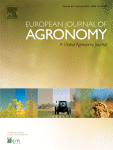Ver ítem
- xmlui.general.dspace_homeCentros Regionales y EEAsCentro Regional Buenos Aires SurEEA BalcarceArtículos científicosxmlui.ArtifactBrowser.ItemViewer.trail
- Inicio
- Centros Regionales y EEAs
- Centro Regional Buenos Aires Sur
- EEA Balcarce
- Artículos científicos
- Ver ítem
Analysis of sink/source relations in bread wheat recombinant inbred lines and commercial cultivars under a high yield potential environment
Resumen
Grain yield in wheat is generally considered to be sink-limited during grain filling. But is this limitation inherent to the crop species or a consequence of the breeding process? A way to ascertain this is by using genetic materials not subject to selection. Grain yield could be analyzed as the product between: (i) grain number per unit area, (ii) the potential grain weight (i.e. weight per grain obtained without source limitation); and (iii) the degree
[ver mas...]
Grain yield in wheat is generally considered to be sink-limited during grain filling. But is this limitation inherent to the crop species or a consequence of the breeding process? A way to ascertain this is by using genetic materials not subject to selection. Grain yield could be analyzed as the product between: (i) grain number per unit area, (ii) the potential grain weight (i.e. weight per grain obtained without source limitation); and (iii) the degree of sink limitation (DSL). The product of the first two components defines the crop sink capacity (SICA), and the DSL could be assessed as the quotient between weight per grain and its potential weight. Such an analysis was carried out in a RIL population derived from the cross between Baguette 10 and Klein Chajá (Argentinean cultivars with
contrasting grain number). Three field experiments were conducted at Balcarce, Argentina during the 2013,
2014 and 2015 crop seasons, under non-limiting conditions; 146 recombinant inbred lines (RILs), the parental cultivars and other commercial cultivars were evaluated. At maturity, grain yield and grain weight were determined.
The potential grain weight was obtained by thinning rows at the beginning of grain filling. Grain number m−2 was calculated as grain yield/grain weight. Grain yield was highly associated with SICA; the slope of the relationship between grain yield and SICA was lower than the expected 1:1 ratio above ∼8 tons ha−1,
indicating that the source for grain filling becomes a limiting factor when SICA increases, particularly in the RILs. This suggests that much of the sink limitation observed in modern wheat cultivars may be the result of genetic improvement.
[Cerrar]

Fuente
European journal of agronomy 93 : 82-87. (February 2018)
Fecha
2018-02
ISSN
1161-0301
Formato
pdf
Tipo de documento
artículo
Palabras Claves
Derechos de acceso
Restringido
 Excepto donde se diga explicitamente, este item se publica bajo la siguiente descripción: Creative Commons Attribution-NonCommercial-ShareAlike 2.5 Unported (CC BY-NC-SA 2.5)
Excepto donde se diga explicitamente, este item se publica bajo la siguiente descripción: Creative Commons Attribution-NonCommercial-ShareAlike 2.5 Unported (CC BY-NC-SA 2.5)

